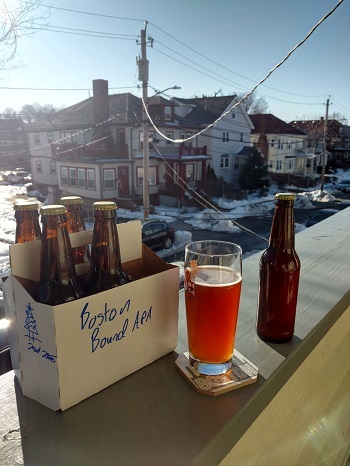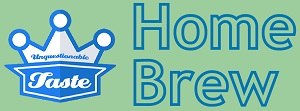Blue And Gold

Home Brewer and Country of Origin: Bobby McDonough of Boston, MA, United States
Date Reviewed: 3-24-17
The third Monday of April is noted on the calendar as a holiday known as Patriots' Day. The holiday was first proclaimed in 1894 as a public observance celebrating the famous first battles of the American Revolution, the battles of Lexington and Concord. Patriots' Day is an official state holiday in Massachusetts and also in Maine, which at the time of the battles in 1775, was part of Massachusetts (Maine, known then as the District of Maine, gained statehood as part of the Missouri Compromise in 1820). The holiday's schedule is full of re-enactments of the battles as well as the Midnight Rides of both Paul Revere and William Dawes with warnings of incoming Red Coats being called out to the passersby. Today, the holiday is heavily associated with Boston sports, especially the Boston Marathon and the Red Sox. The Red Sox have had a game scheduled at their home ballpark of Fenway Park every season since 1959, and due to agreements with the MLB and the Players Association, the games are played early so that they finish when the marathon is expected to flow through nearby Kenmore Square. This particular home brew, produced by a runner friend of ours in Boston, is an American style pale ale whose name is reflective of the brewer's plans to run the 2017 Boston Marathon. This year will be the 121st running of the 26.2 mile long race, which has been held on every Patriots' Day since 1897, making it the world's oldest annually run marathon. The race was created in part to historically connect Athens and The United States with their respective fights for liberty. The Marathon, which is considered one of the more difficult (because of its changes in elevation) and the most famous road race in the world, starts in the Boston commuter suburb of Hopkinton and finishes in the Copley Square area of Back Bay in Boston, in front of the Boston Public Library. It is New England's most watched annual sporting event, and more than thirty thousand runners participate in it each year. The race is broadcast live around the world and brings in nearly $200 million in economic activity for the Greater Boston area each year.
Aside from the prestige, the athletes, and the general celebration, the Boston Marathon is noted for its role in charitable giving. Times to qualify for automatic entry into the marathon are very difficult to achieve for even experienced runners, so the majority of non-professional participants gain entry by fundraising for various non-profit organizations. Over the last handful of races, the marathon and indeed the sport of running have increased in popularity. Road crews aren't planning on widening Commonwealth Avenue or Boylston Street anytime soon, so getting in is increasingly difficult. As qualifying times have been quickly approaching the three hour mark for the fastest male group, fundraising minimums have generally increased as well, with many above $7,000. In 2016, runners participated on behalf of more than 200 charitable organizations, raising more than $30 million for non-profits such as the National Leukemia & Lymphoma Society, Goodwill, the YMCA, Boston Children's Hospital, Dana-Farber Cancer Institute, the Red Cross, and others. If you know someone who has participated on a charity team for the Boston Marathon, you're probably aware of the various efforts that go into raising the pledged funds. With high fundraising goals, people have to be pretty creative and charitable when asking their friends, co-workers and family for money. Of course, in the case of our friend Bobby, we couldn't pass up the opportunity to review another home brew, but for others, it may mean offering donors baked goods, raffles, embarrassing karaoke, a loaner puppy for a day, March Madness brackets, bowling events, sports tickets, homemade scarves, custom Facebook profile pictures, getting a humiliating haircut, and everything in between. All good fun, and for good causes. The marathon and its ability to get people working together, building a better place to be, has had a profound effect on the city, all of which was made vividly apparent in 2013.
The entire world witnessed what amazing things can be done when the good of humanity is challenged: Runners continuing on a few more miles to donate blood after finishing the marathon; Countless donations from people all over the globe; First responders running towards the sounds of gunshots and explosions; Hospitals working around the clock; Sports teams from across the major leagues paying tributes to Boston; Residents opening their doors to tourists whose hotels were closed off; And of course, the One Fund. All of these actions showing exactly how to respond when hatred tries to divide. April 15th, the anniversary of the 2013 Boston Marathon, has been proclaimed as One Boston Day, a day which mayor Marty Walsh describes as a day of community growing, celebrating diversity, charitable giving, volunteering, and even buying a pint for the pubgoer next to you. And although the Boston Marathon is the pinnacle competition of the sport of running, with champions hailing from around the globe, for most, the race means as much about finishing as it does the cause they raise money for. Whether its finding a cure for a disease, funding educational scholarships, helping rescued animals find homes, or increasing the quality of life for those with disabilities, the efforts embody the spirit of the city, its residents, and the marathon's participants. Sure, there's prize money and notoriety to be had, but everyone runs the same course, deals with the same weather, struggles up the same Heartbreak Hill, trains for several months, and for 99.98% of the runners, there's so much more to the race than winning.
Some say running isn't a team sport. Boston shows otherwise.
Date Sampled: 3-17-17 At: 39 Claymoss Road, Brighton, Boston, MA 02135, USA
Beer Style: American Pale Ale
Alcohol by Volume: 5.00%
Serving Type: Homebrew 12 oz Bottle, 16 oz Glass
Rating: 3.12
 Boston Bound APA
Boston Bound APA



